Sonic’s Wii debut was built up by some to be his last chance; after the disappointment of his first next-gen appearance, there seems to be a lot riding on Sonic and the Secret Rings to start salvaging his reputation. How does it do?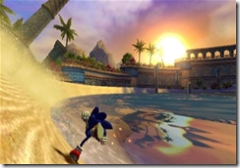
At first the automatic acceleration feels very strange indeed. You can brake with 1 and jump with 2, but Sonic’s pretty determined to keep moving, which is absolutely great. Due to the fairly strict route the game keeps you on, most of your control is steering to avoid hazards, which means there’s much less falling off levels that’s blighted him since Sonic Adventure. In fact, there’s even automatic jumping in some points to make sure you get from A to B safely.
Removing some of the game’s interactivity might seem like a step backwards, but I don’t think Sonic’s ever really been about freedom of movement; in terms of controls, there should be as few obstacles as possible between him and top speed.
It doesn’t take long to get used to though, and really starts to make sense when the levels become more complicated – it moves so quickly that there’s simply no time to play it like a traditional 3D Sonic game, so it becomes a test of reactions and skills rather than manoeuvring Sonic into place. That said, there are a few times when backtracking to hit that last enemy becomes very tiring.
Sonic and the Secret Rings also does much to prove the Wii’s graphical power: the levels are vivid and densely constructed, with detailed models and textures throughout. It also moves incredibly quickly, even when it’s throwing around smoke, lighting, blur effects and an enormous draw distance.
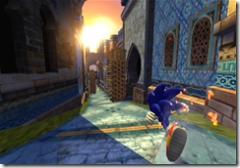 Structure
Structure
The game’s level progression reminds me of Billy Hatcher for some reason: within each world (or Zone, I suppose) there are numerous challenges, ranging from races to ring collecting, and your prowess in each defines your progress. When you complete a mission, another one opens up, and by repeating this you open up other worlds.
The missions are very varied. So far my favourites are the “Hands Off!” challenges, where you have to finish with no rings, and the “Rampage” missions, where you defeat a set number of enemies, ranging from a single hard-to-reach robot to 40 resurrected thieves. They’re mostly shorter than the standard levels, and benefit from some very tight and clever design. Even though “don’t kill enemies!” sounds like a rubbish idea for a Sonic level, it gives the game a puzzle kind of element that gives the gameplay some needed expansion. In a game where the running is done for you, these levels let you slow down and use some fine skills to succeed.
Each mission cleared gives you experience points, a genuine first for a Sonic game. When you’ve got enough experience your stats will increase and you learn new skills – these can be anything from increased acceleration to longer homing attacks and Soul Gauge recovery. Returning to early levels let you show off your increased skills, both as a player and with these equipped skills, making it easier to achieve higher scores and unlock more goodies.
These goodies are contained in the game’s brilliantly-named “Special Book“, and can be anything from the history of Sonic to developer artwork, music, special ranks and more. These sequential revelations help to spur you on to discover more of the game.
Final thoughts
I was really excited about Sonic and the Secret Rings; although I didn’t subscribe to the belief it was his last roll of the dice, I did know it was an important game to Sonic fans and casual gamers, and for Sega to make probably their most risky Sonic game for some time was a brave move that could easily have backfired.
Sonic and the Secret Rings injects the thrill back into Sonic with levels that flow well and sections encourage high speeds. The new skill system makes challenging cleared levels worthwhile, and the Special Book and experience points are worthy rewards. With the exception of the difficulty of backtracking, the camera and controls both work seamlessly, feeling responsive and never intrusive.
Overall this is as close to the Sonic game I wanted as I think is realistic. Although a little more in the happiness department would have gone down well – more tunes instead of rap-rock, more blue skies and more colour – this is a superb and addictive Sonic game that is a massive amount of fun to play.
Technorati tags:
Wii,
Sega,
Sonic
 episode of the James Newton Podcast (suggestions for snappier names welcomed)!, featuring five of the very best games released on the DS in the coming months. There’s some adult entertainment, juvenile fun and probably the best reason to leave the house this summer. To listen to the podcast, simply right-click and save this link, then pop it open with your chosen mp3 player.
episode of the James Newton Podcast (suggestions for snappier names welcomed)!, featuring five of the very best games released on the DS in the coming months. There’s some adult entertainment, juvenile fun and probably the best reason to leave the house this summer. To listen to the podcast, simply right-click and save this link, then pop it open with your chosen mp3 player.I’m listening to Why You Wanna Treat Me So Bad? by Prince, from The Hits 1
 PlayStation 3 launch, but when a radio professional came down to conduct some interviews for BBC Radio York I thought I’d better let him do his job.
PlayStation 3 launch, but when a radio professional came down to conduct some interviews for BBC Radio York I thought I’d better let him do his job.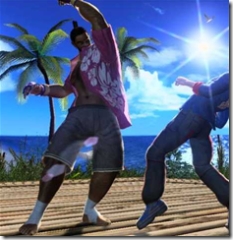



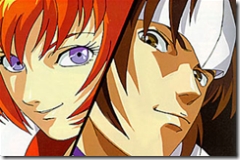
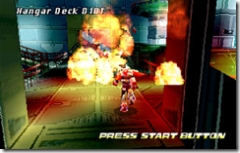
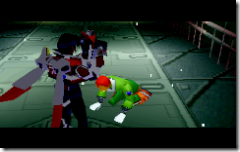

 Structure
Structure My name is James Newton, and this is my website - a collection of my writings about
videogames, music and all my other thoughts.
My name is James Newton, and this is my website - a collection of my writings about
videogames, music and all my other thoughts.